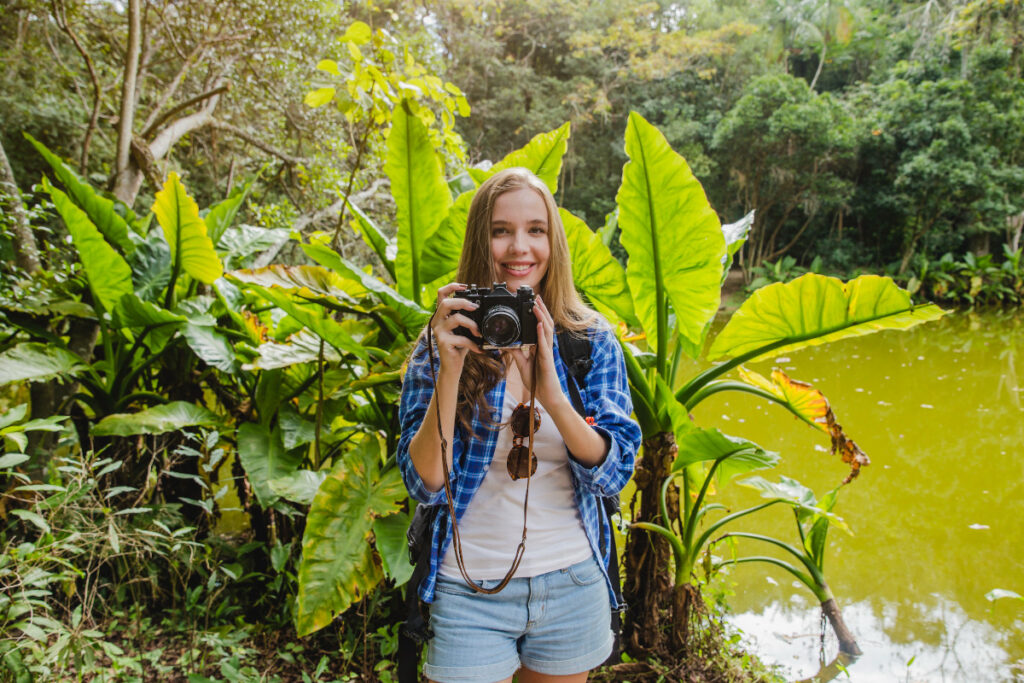Main Trails near Casa Balae
The surroundings of Casa Balae offer a network of routes that combine beaches, streams, mangroves, and tropical rainforest. These paths have been explored and documented by biodiversity experts and local guides, ensuring an authentic and well-planned experience.
Notable trails:
-
Main Forest Trail: 5 km of primary vegetation with trees over 70 meters tall. Ideal for birdwatching species such as Pyrilia pulchra and Manacus vitellinus.
-
Carrizalito Trail: 7.5 km reaching 225 meters above sea level, with panoramic views and sightings of species like Crax rubra and Jacamerops aureus.
-
Cerro Finito: 2.5 km offering a 360° view of the forest and sea. A prime spot to find the Spizaetus ornatus, an eagle classified as near-threatened.
-
Guachalito Streams Trail: 4.8 km route with small waterfalls and crystal-clear pools.
-
Beach Trail to Termales: 9.7 km along the coast, transitioning from mangrove to rainforest and offering views of aquatic birds.
Practical tip: Most hikes can be adapted to different difficulty levels, and it’s highly recommended to go with certified guides who know both the biodiversity and the history of the area.
Flora and Fauna: A Close Encounter with Biodiversity
These trails allow encounters with everything from tiny glass frogs to majestic birds of prey. The variety of habitats—primary forest, secondary vegetation, mangrove, and rocky coast—supports the presence of unique species.
Notable fauna:
-
Birds: Among the 81 species recorded in the area are the endemic Bucco noanamae, the Ramphastos brevis, and hummingbirds like Phaethornis yaruqui.
-
Amphibians and reptiles: Species such as the poisonous frog Oophaga solanensis and the green iguana (Iguana iguana) are common sights.
-
Mammals: Howler monkeys, sloths, and fruit bats enrich the hiking experience.
Notable flora:
-
Emergent trees such as Dialium guianense (cuangare) and Prioria copaifera (cativo).
-
Palms and lianas forming natural “bridges.”
-
Orchids and bromeliads thriving on tree branches, benefiting from constant humidity.
An Immersive Experience: Hiking that Engages the Senses
Hiking in the jungle is not only about observing—it’s about feeling. The sound of birds mixed with the murmur of streams, the scent of damp earth, the texture of giant leaves, and the filtered sunlight through the canopy create a unique sensory show.
Complementary activities during the hike:
-
Nature photography: Spots like Cerro Finito offer ideal lighting conditions.
-
Species identification: With the help of local guides and apps like eBird or Merlin Bird ID.
-
Interpretive stops: Explanations about each species’ ecological role and its connection to local culture.
Real-life example: On the Carrizalito Trail, visitors have witnessed courtship displays of the Manacus vitellinus, whose bright yellow plumage glows in the sunlight.
Safety and Visitor Recommendations
Exploring the jungle requires preparation to enjoy it safely and minimize environmental impact.
Key recommendations:
-
Wear lightweight long-sleeve clothing and non-slip footwear.
-
Bring biodegradable insect repellent and sunscreen.
-
Stay on marked trails to avoid damaging the ecosystem.
-
Do not feed wildlife or collect plants.
-
Respect group pace and timing, especially on longer hikes.
Relevant fact: 80% of international visitors hiking in Nuquí say that having a local guide greatly enriched their experience and ensured their safety.
Responsible Tourism: Caring for What You Love
Nuquí’s trails are more than tourist routes—they are lifelines for entire communities of plants and animals. Conserving these spaces is a shared responsibility between residents, operators, and visitors.
Sustainable best practices:
-
Support local ecotourism initiatives.
-
Participate in biodiversity monitoring programs.
-
Spread awareness about the Chocó Biogeographic region’s importance as a global biodiversity hotspot.
Suggested link: Learn more about responsible nature tourism in Colombia at procolombia.co.
Nuquí’s trails offer far more than a walk—they are a gateway into the heart of the Chocó Biogeographic region. Each route is a living lesson on ecological interdependence, cultural resilience, and natural beauty.
Walking from Casa Balae along any of these paths is an experience that combines adventure, knowledge, and a deep connection with one of the richest ecosystems on the planet. If you’re looking for a destination where every step brings discovery, the jungle of Nuquí awaits you—with open arms and a ready camera.




